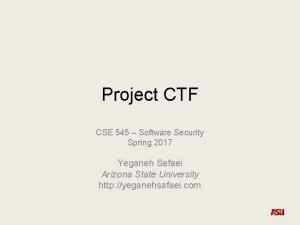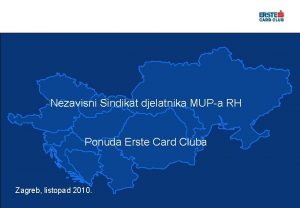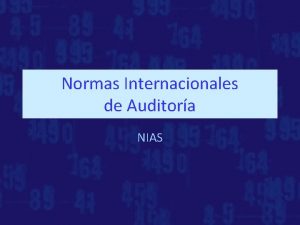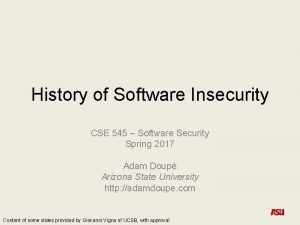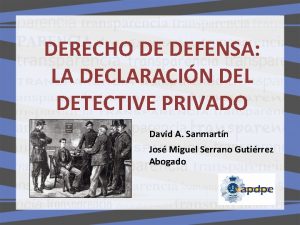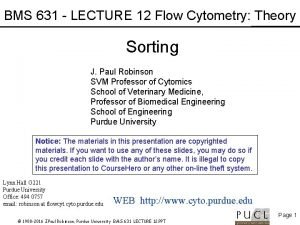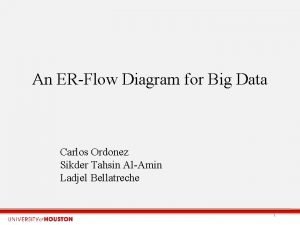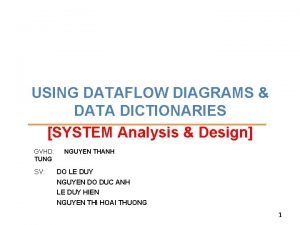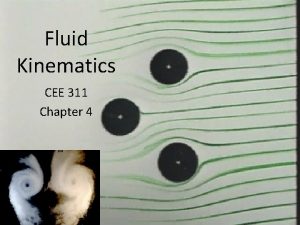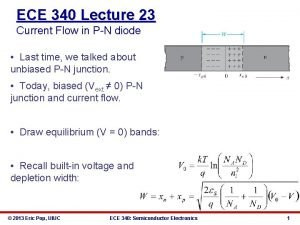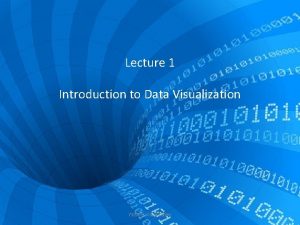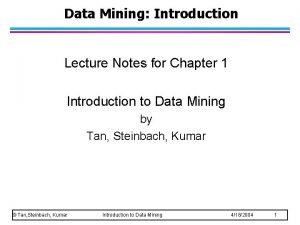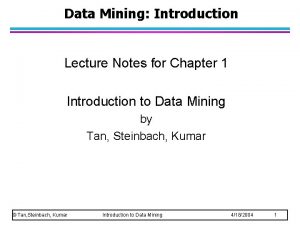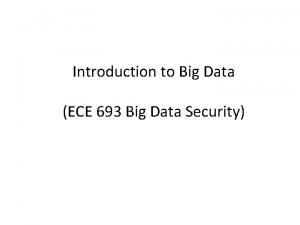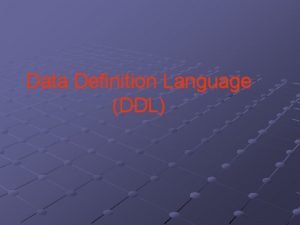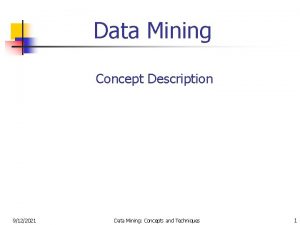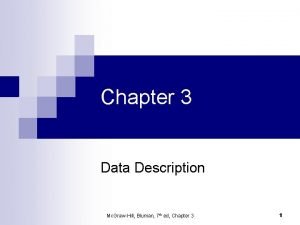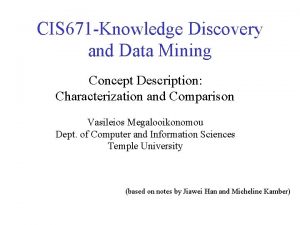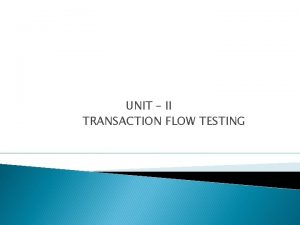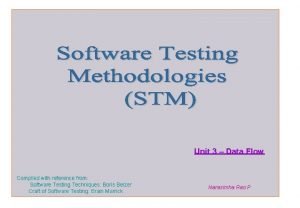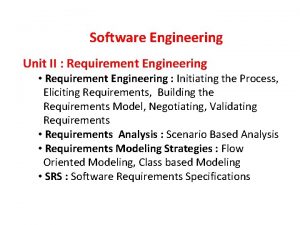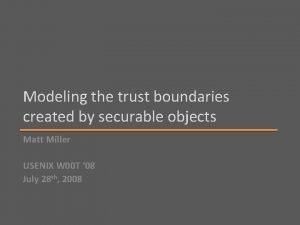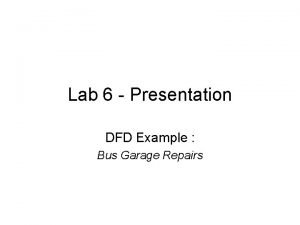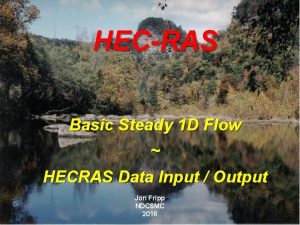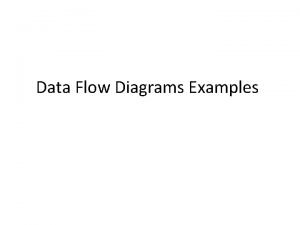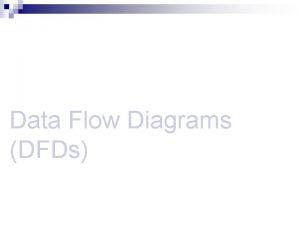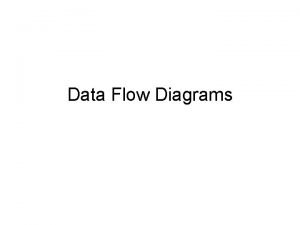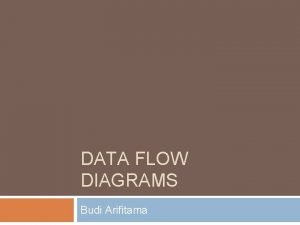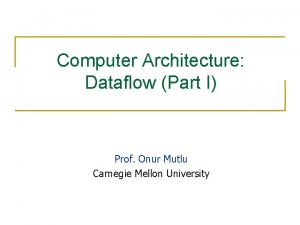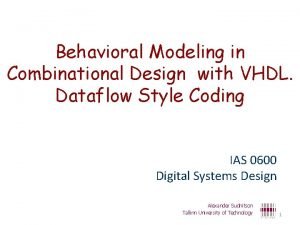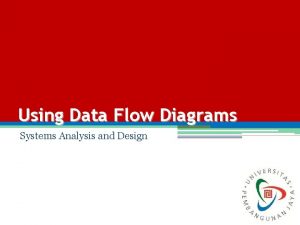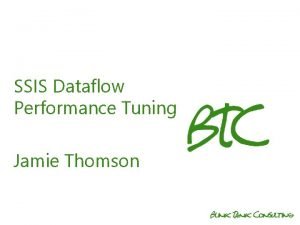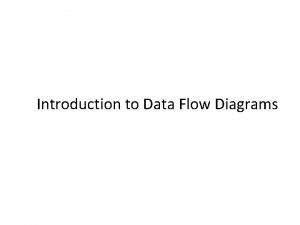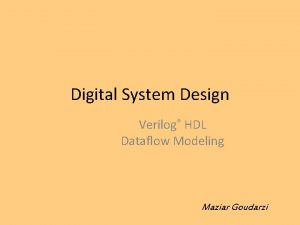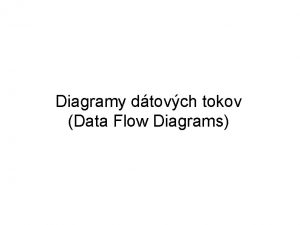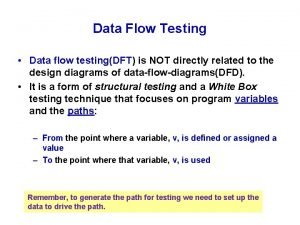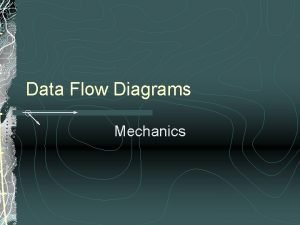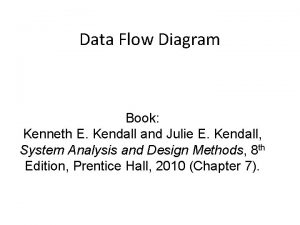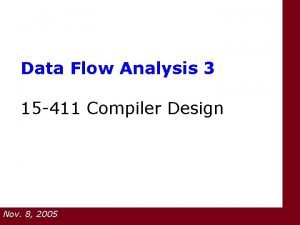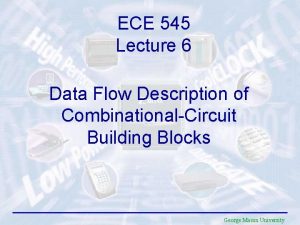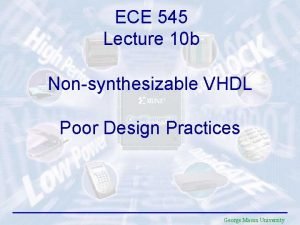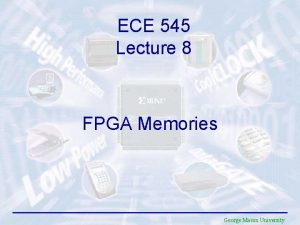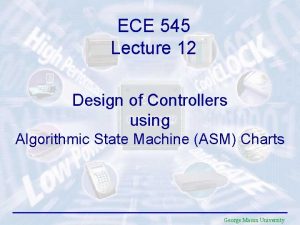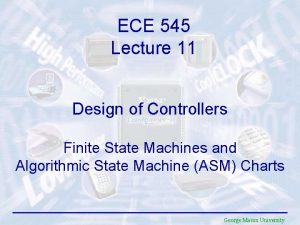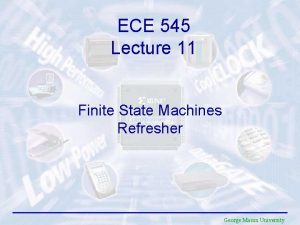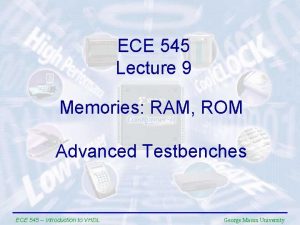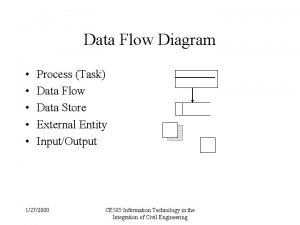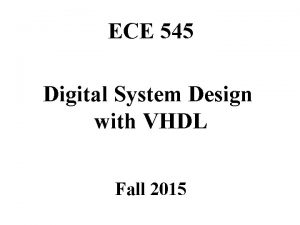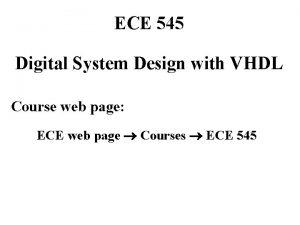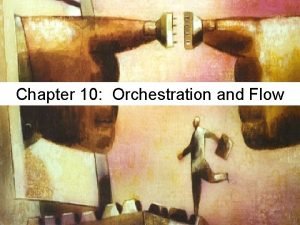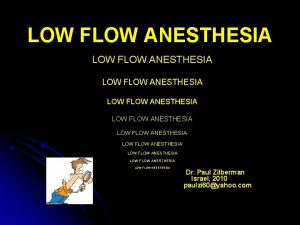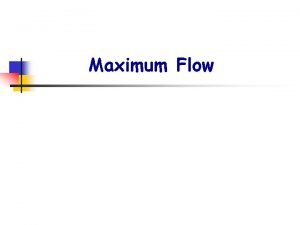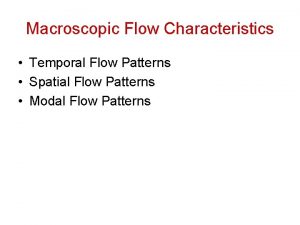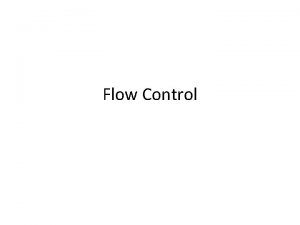ECE 545 Lecture 5 Data Flow Description of



































































- Slides: 67

ECE 545 Lecture 5 Data Flow Description of Combinational-Circuit Building Blocks George Mason University

Required reading • P. Chu, RTL Hardware Design using VHDL Chapter 7, Combinational Circuit Design: Practice 2

Fixed Shifters & Rotators ECE 448 – FPGA and ASIC Design with VHDL 3

Fixed Logical Shift Right in VHDL SIGNAL A : SIGNAL C: STD_LOGIC_VECTOR(3 DOWNTO 0); A(3) A(2) A(1) A(0) 4 A A >>1 L C C 4 ‘ 0’ A(3) A(2) A(1) C= 4

Fixed Arithmetic Shift Right in VHDL SIGNAL A : SIGNAL C: STD_LOGIC_VECTOR(3 DOWNTO 0); A(3) A(2) A(1) A(0) 4 A A >>1 A C C 4 A(3) A(2) A(1) C= 5

Fixed Rotation in VHDL SIGNAL A : SIGNAL C: STD_LOGIC_VECTOR(3 DOWNTO 0); 4 A(3) A(2) A(1) A(0) A A <<< 1 C C 4 A(2) A(1) A(0) A(3) 6

Multiplexers ECE 448 – FPGA and ASIC Design with VHDL 7

2 -to-1 Multiplexer s w 0 0 w 1 1 f (a) Graphical symbol s f 0 w 0 1 w 1 (b) Truth table 8

VHDL code for a 2 -to-1 Multiplexer LIBRARY ieee ; USE ieee. std_logic_1164. all ; ENTITY mux 2 to 1 IS PORT ( w 0, w 1, s : IN STD_LOGIC ; f : OUT STD_LOGIC ) ; END mux 2 to 1 ; ARCHITECTURE dataflow OF mux 2 to 1 IS BEGIN f <= w 0 WHEN s = '0' ELSE w 1 ; END dataflow ; 9

Cascade of two multiplexers w 3 0 w 2 1 0 w 1 y 1 s 2 s 1 10

VHDL code for a cascade of two multiplexers LIBRARY ieee ; USE ieee. std_logic_1164. all ; ENTITY mux_cascade IS PORT ( w 1, w 2, w 3: IN STD_LOGIC ; s 1, s 2 : IN STD_LOGIC ; f : OUT STD_LOGIC ) ; END mux_cascade ; ARCHITECTURE dataflow OF mux 2 to 1 IS BEGIN f <= w 1 WHEN s 1 = ‘ 1' ELSE w 2 WHEN s 2 = ‘ 1’ ELSE w 3 ; END dataflow ; 11

4 -to-1 Multiplexer s 0 s 1 w w 0 00 1 01 2 10 3 11 (a) Graphic symbol f s 1 s 0 f 0 0 w 0 1 w 1 0 w 1 1 w 0 1 2 3 (b) Truth table 12

VHDL code for a 4 -to-1 Multiplexer LIBRARY ieee ; USE ieee. std_logic_1164. all ; ENTITY mux 4 to 1 IS PORT ( w 0, w 1, w 2, w 3 s f END mux 4 to 1 ; : IN : OUT STD_LOGIC ; STD_LOGIC_VECTOR(1 DOWNTO 0) ; STD_LOGIC ) ; ARCHITECTURE dataflow OF mux 4 to 1 IS BEGIN WITH s SELECT f <= w 0 WHEN "00", w 1 WHEN "01", w 2 WHEN "10", w 3 WHEN OTHERS ; END dataflow ; 13

Decoders ECE 448 – FPGA and ASIC Design with VHDL 14

2 -to-4 Decoder En w w 1 0 y y 3 2 1 0 0 0 1 1 0 0 1 1 0 0 x x 0 0 (a) Truth table w 1 w 0 En y 3 y 2 y 1 y 0 (b) Graphical symbol 15

VHDL code for a 2 -to-4 Decoder LIBRARY ieee ; USE ieee. std_logic_1164. all ; ENTITY dec 2 to 4 IS PORT ( w : IN En : IN y : OUT END dec 2 to 4 ; STD_LOGIC_VECTOR(1 DOWNTO 0) ; STD_LOGIC_VECTOR(3 DOWNTO 0) ) ; ARCHITECTURE dataflow OF dec 2 to 4 IS SIGNAL Enw : STD_LOGIC_VECTOR(2 DOWNTO 0) ; BEGIN Enw <= En & w ; WITH Enw SELECT y <= “ 0001" WHEN "100", "0010" WHEN "101", "0100" WHEN "110", “ 1000" WHEN "111", "0000" WHEN OTHERS ; END dataflow ; 16

Encoders ECE 448 – FPGA and ASIC Design with VHDL 17

Priority Encoder w 0 y 0 w 1 y 1 w 2 z w 3 w 2 w 1 w 0 0 0 1 x x 0 1 x x x y 1 y 0 z d 0 0 1 1 1 1 d 0 1 18

VHDL code for a Priority Encoder LIBRARY ieee ; USE ieee. std_logic_1164. all ; ENTITY priority IS PORT ( w : IN y : OUT z : OUT END priority ; STD_LOGIC_VECTOR(3 DOWNTO 0) ; STD_LOGIC_VECTOR(1 DOWNTO 0) ; STD_LOGIC ) ; ARCHITECTURE dataflow OF priority IS BEGIN y <= "11" WHEN w(3) = '1' ELSE "10" WHEN w(2) = '1' ELSE "01" WHEN w(1) = '1' ELSE "00" ; z <= '0' WHEN w = "0000" ELSE '1' ; END dataflow ; 19

Adders ECE 448 – FPGA and ASIC Design with VHDL 20

Adder mod 28 8 8 X Y S 8 21

VHDL code for an Adder mod 28 LIBRARY ieee ; USE ieee. std_logic_1164. all ; USE ieee. std_logic_unsigned. all ; ENTITY adder 16 IS PORT ( X Y S END adder 16 ; : IN : OUT STD_LOGIC_VECTOR(7 DOWNTO 0) ; STD_LOGIC_VECTOR(7 DOWNTO 0) ) ; ARCHITECTURE dataflow OF adder 16 IS BEGIN S <= X + Y ; END dataflow ; 22

16 -bit Unsigned Adder 16 16 X Y Cout Cin S 16 23

Operations on Unsigned Numbers For operations on unsigned numbers USE ieee. std_logic_unsigned. all and signals of the type STD_LOGIC_VECTOR OR USE ieee. numeric_std. all, signals of the type UNSIGNED and conversion functions: std_logic_vector(), unsigned() 24

Signed and Unsigned Types Behave exactly like STD_LOGIC_VECTOR plus, they determine whether a given vector should be treated as a signed or unsigned number. Require USE ieee. numeric_std. all; 25

VHDL code for a 16 -bit Unsigned Adder LIBRARY ieee ; USE ieee. std_logic_1164. all ; USE ieee. std_logic_unsigned. all ; ENTITY adder 16 IS PORT ( Cin X Y S Cout END adder 16 ; : IN : OUT STD_LOGIC ; STD_LOGIC_VECTOR(15 DOWNTO 0) ; STD_LOGIC ) ; ARCHITECTURE dataflow OF adder 16 IS SIGNAL Sum : STD_LOGIC_VECTOR(16 DOWNTO 0) ; BEGIN Sum <= ('0' & X) + Y + Cin ; S <= Sum(15 DOWNTO 0) ; Cout <= Sum(16) ; END dataflow ; 26

Addition of Unsigned Numbers (1) LIBRARY ieee ; USE ieee. std_logic_1164. all ; USE ieee. numeric_std. all ; ENTITY adder 16 IS PORT ( Cin X Y S Cout END adder 16 ; : IN : OUT STD_LOGIC ; STD_LOGIC_VECTOR(15 DOWNTO 0) ; STD_LOGIC ) ; 27

Addition of Unsigned Numbers (2) ARCHITECTURE dataflow OF adder 16 IS SIGNAL Xu : UNSIGNED(15 DOWNTO 0); SIGNAL Yu: UNSIGNED(15 DOWNTO 0); SIGNAL Su : UNSIGNED(16 DOWNTO 0) ; BEGIN Xu <= unsigned(X); Yu <= unsigned(Y); Su <= ('0' & Xu) + Yu + unsigned(‘ 0’ & Cin) ; S <= std_logic_vector(Su(15 DOWNTO 0)) ; Cout <= Su(16) ; END dataflow ; 28

Operations on Signed Numbers For operations on signed numbers USE ieee. std_logic_signed. all and signals of the type STD_LOGIC_VECTOR OR USE ieee. numeric_std. all, signals of the type SIGNED, and conversion functions: std_logic_vector(), signed() 29

Multipliers ECE 448 – FPGA and ASIC Design with VHDL 30

Unsigned vs. Signed Multiplication Unsigned Signed 1111 x 1111 15 x 15 1111 x 1111 -1 x -1 11100001 225 00000001 1 31

8 x 8 -bit Unsigned Multiplier 8 8 a b * c U 16 32

Multiplication of unsigned numbers LIBRARY ieee; USE ieee. std_logic_1164. all; USE ieee. std_logic_unsigned. all ; entity multiply is port( a : in STD_LOGIC_VECTOR(7 downto 0); b : in STD_LOGIC_VECTOR(7 downto 0); c : out STD_LOGIC_VECTOR(15 downto 0) ); end multiply; architecture dataflow of multiply is begin c <= a * b; end dataflow; 33

8 x 8 -bit Signed Multiplier 8 8 a b * c S 16 34

Multiplication of signed numbers LIBRARY ieee; USE ieee. std_logic_1164. all; USE ieee. std_logic_signed. all ; entity multiply is port( a : in STD_LOGIC_VECTOR(7 downto 0); b : in STD_LOGIC_VECTOR(7 downto 0); c : out STD_LOGIC_VECTOR(15 downto 0) ); end multiply; architecture dataflow of multiply is begin c <= a * b; end dataflow; 35

8 x 8 -bit Unsigned and Signed Multiplier 8 16 8 a b cu cs 16 36

Multiplication of signed and unsigned numbers LIBRARY ieee; USE ieee. std_logic_1164. all; USE ieee. numeric_std. all ; entity multiply is port( a : in STD_LOGIC_VECTOR(7 downto 0); b : in STD_LOGIC_VECTOR(7 downto 0); cu : out STD_LOGIC_VECTOR(15 downto 0); cs : out STD_LOGIC_VECTOR(15 downto 0) ); end multiply; architecture dataflow of multiply is begin -- signed multiplication cs <= STD_LOGIC_VECTOR(SIGNED(a)*SIGNED(b)); -- unsigned multiplication cu <= STD_LOGIC_VECTOR(UNSIGNED(a)*UNSIGNED(b)); end dataflow; 37

Comparators ECE 448 – FPGA and ASIC Design with VHDL 38

4 -bit Unsigned Number Comparator 4 4 A B Aeq. B Agt. B Alt. B U 39

VHDL code for a 4 -bit Unsigned Number Comparator LIBRARY ieee ; USE ieee. std_logic_1164. all ; USE ieee. std_logic_unsigned. all ; ENTITY compare IS PORT ( A, B : IN Aeq. B, Agt. B, Alt. B : OUT END compare ; STD_LOGIC_VECTOR(3 DOWNTO 0) ; STD_LOGIC ) ; ARCHITECTURE dataflow OF compare IS BEGIN Aeq. B <= '1' WHEN A = B ELSE '0' ; Agt. B <= '1' WHEN A > B ELSE '0' ; Alt. B <= '1' WHEN A < B ELSE '0' ; END dataflow ; 40

VHDL code for a 4 -bit Signed Number Comparator LIBRARY ieee ; USE ieee. std_logic_1164. all ; USE ieee. std_logic_signed. all ; ENTITY compare IS PORT ( A, B : IN Aeq. B, Agt. B, Alt. B : OUT END compare ; STD_LOGIC_VECTOR(3 DOWNTO 0) ; STD_LOGIC ) ; ARCHITECTURE dataflow OF compare IS BEGIN Aeq. B <= '1' WHEN A = B ELSE '0' ; Agt. B <= '1' WHEN A > B ELSE '0' ; Alt. B <= '1' WHEN A < B ELSE '0' ; END dataflow ; 41

Arithmetic operations Synthesizable arithmetic operations: • Addition, + • Subtraction, • Comparisons, >, >=, <, <= • Multiplication, * • Division by a power of 2, /2**6 (equivalent to right shift) 42

Arithmetic operations The result of synthesis of an arithmetic operation is a - combinational circuit - without pipelining. The exact internal architecture used (and thus delay and area of the circuit) may depend on the timing constraints specified during synthesis (e. g. , the requested maximum clock frequency). 43

Integer Types Operations on signals of the integer types: INTEGER, NATURAL, and their sybtypes, such as TYPE day_of_month IS RANGE 1 TO 31; are synthesizable in the range -(231 -1). . 231 -1 for INTEGERs and their subtypes 0. . 231 -1 for NATURALs and their subtypes 44

Integer Types Operations on signals (variables) of the integer types: INTEGER, NATURAL, are less flexible and more difficult to control than operations on signals (variables) of the type STD_LOGIC_VECTOR UNSIGNED, and thus are recommened to be avoided by beginners. 45

ROM ECE 448 – FPGA and ASIC Design with VHDL 46

8 -bit Variable Rotator Left 3 Addr 8 x 16 ROM Dout 16 C 47

Instruction ROM example (1) LIBRARY ieee; USE ieee. std_logic_1164. all; USE ieee. numeric_std. all; ENTITY rom IS PORT ( Addr : IN STD_LOGIC_VECTOR(2 DOWNTO 0); Dout : OUT STD_LOGIC_VECTOR(15 DOWNTO 0) ); END rom; 48

Instruction ROM example (2) ARCHITECTURE dataflow OF rom IS SIGNAL temp: INTEGER RANGE 0 TO 7; TYPE vector_array IS ARRAY (0 to 7) OF STD_LOGIC_VECTOR(15 DOWNTO 0); CONSTANT memory : vector_array : = ( X” 800 A", X"D 459", X"A 870", X"7853", X"650 D", X"642 F", X"F 742", X"F 548"); BEGIN temp <= to_integer(unsigned(Addr)); Dout <= memory(temp); END dataflow; 49

Buffers ECE 448 – FPGA and ASIC Design with VHDL 50

Tri-state Buffer e x f e= 0 (a) A tri-state buffer e x f 0 0 1 1 Z Z 0 1 0 1 x x f e= 1 f (b) Equivalent circuit (c) Truth table 51

Four types of Tri-state Buffers 52

Tri-state Buffer – example (1) LIBRARY ieee; USE ieee. std_logic_1164. all; ENTITY tri_state IS PORT ( ena: IN STD_LOGIC; input: IN STD_LOGIC; output: OUT STD_LOGIC ); END tri_state; 53

Tri-state Buffer – example (2) ARCHITECTURE dataflow OF tri_state IS BEGIN output <= input WHEN (ena = ‘ 1’) ELSE ‘Z’; END dataflow; 54

MLU Example 55

MLU Block Diagram A 0 A 1 MUX_0 MUX_4_1 1 NEG_A MUX_1 MUX_2 Y 1 IN 0 IN 1 IN 2 0 OUTPUT SEL 0 IN 3 SEL 1 1 Y NEG_Y B 0 B 1 L 0 1 MUX_3 NEG_B 56

MLU: Entity Declaration LIBRARY ieee; USE ieee. std_logic_1164. all; ENTITY mlu IS PORT( NEG_A : IN STD_LOGIC; NEG_B : IN STD_LOGIC; NEG_Y : IN STD_LOGIC; A: IN STD_LOGIC; B: IN STD_LOGIC; L 1 : IN STD_LOGIC; L 0 : IN STD_LOGIC; Y: OUT STD_LOGIC ); END mlu; 57

MLU: Architecture Declarative Section ARCHITECTURE mlu_dataflow OF mlu IS SIGNAL SIGNAL A 1 : STD_LOGIC; B 1 : STD_LOGIC; Y 1 : STD_LOGIC; MUX_0 : STD_LOGIC; MUX_1 : STD_LOGIC; MUX_2 : STD_LOGIC; MUX_3 : STD_LOGIC; L: STD_LOGIC_VECTOR(1 DOWNTO 0); 58

MLU - Architecture Body BEGIN A 1<= NOT A WHEN (NEG_A='1') ELSE A; B 1<= NOT B WHEN (NEG_B='1') ELSE B; Y <= NOT Y 1 WHEN (NEG_Y='1') ELSE Y 1; MUX_0 <= A 1 MUX_1 <= A 1 MUX_2 <= A 1 MUX_3 <= A 1 AND B 1; OR B 1; XNOR B 1; L <= L 1 & L 0; with (L) select Y 1 <= MUX_0 MUX_1 MUX_2 MUX_3 WHEN "00", WHEN "01", WHEN "10", WHEN OTHERS; END mlu_dataflow; 59

Combinational Logic Synthesis for Beginners ECE 448 – FPGA and ASIC Design with VHDL 60

Simple rules for beginners For combinational logic, use only concurrent statements • • concurrent signal assignment ( ) conditional concurrent signal assignment (when-else) selected concurrent signal assignment (with-select-when) generate scheme for equations (for-generate) 61

Simple rules for beginners For circuits composed of - simple logic operations (logic gates) - simple arithmetic operations (addition, subtraction, multiplication) - shifts/rotations by a constant use • concurrent signal assignment ( ) 62

Simple rules for beginners For circuits composed of - multiplexers - decoders, encoders - tri-state buffers use • conditional concurrent signal assignment (when-else) (ending with ELSE) • selected concurrent signal assignment (with-select-when) (ending with WHEN OTHERS; ) 63

Example: VHDL code for a 4 -to-1 MUX LIBRARY ieee ; USE ieee. std_logic_1164. all ; ENTITY mux 4 to 1 IS PORT ( w 0, w 1, w 2, w 3 s f END mux 4 to 1 ; : IN : OUT STD_LOGIC ; STD_LOGIC_VECTOR(1 DOWNTO 0) ; STD_LOGIC ) ; ARCHITECTURE dataflow OF mux 4 to 1 IS BEGIN WITH s SELECT f <= w 0 WHEN "00", w 1 WHEN "01", w 2 WHEN "10", w 3 WHEN OTHERS ; END dataflow ; 64

when-else vs. with-select-when (1) "when-else" should be used when: 1) there is only one condition (and thus, only one else), as in the 2 -to-1 MUX 2) conditions are independent of each other (e. g. , they test values of different signals) 3) conditions reflect priority (as in priority encoder); one with the highest priority need to be tested first. 65

when-else vs. with-select-when (2) "with-select-when" should be used when there is 1) more than one condition 2) conditions are closely related to each other (e. g. , represent different ranges of values of the same signal) 3) all conditions have the same priority (as in the 4 -to-1 MUX). 66

Left vs. right side of the assignment Left side <= Right side <= when-else with-select <= • Internal signals (defined in a given architecture) • Ports of the mode - out - inout Expressions including: • Internal signals (defined in a given architecture) • Ports of the mode - inout 67
 Cis 515 upenn
Cis 515 upenn Cse 545
Cse 545 Cse 545 asu github
Cse 545 asu github 486 dibagi 6 dengan cara bersusun
486 dibagi 6 dengan cara bersusun 01 4929 545
01 4929 545 Nia 545
Nia 545 Cse 545
Cse 545 545 lecrim
545 lecrim 01:640:244 lecture notes - lecture 15: plat, idah, farad
01:640:244 lecture notes - lecture 15: plat, idah, farad Data flow vs control flow
Data flow vs control flow Control flow and data flow computers
Control flow and data flow computers Flow cytometry lecture
Flow cytometry lecture Wpi ece flowchart
Wpi ece flowchart Wpi ece courses
Wpi ece courses Big data data flow diagram
Big data data flow diagram Example of data dictionary in system analysis and design
Example of data dictionary in system analysis and design Eulerian description of fluid flow
Eulerian description of fluid flow Ece 340 uiuc
Ece 340 uiuc Exploratory data analysis lecture notes
Exploratory data analysis lecture notes Bayesian classification in data mining lecture notes
Bayesian classification in data mining lecture notes Data mining lecture notes
Data mining lecture notes Data visualization lecture
Data visualization lecture Data mining lecture notes
Data mining lecture notes Data mining lecture notes
Data mining lecture notes Evolution of bi
Evolution of bi Hafoe mask
Hafoe mask Venturi mask 50 percent
Venturi mask 50 percent Non rebreather mask nursing considerations
Non rebreather mask nursing considerations Laminar vs turbulent flow
Laminar vs turbulent flow Internal versus external flow
Internal versus external flow Energy naturally flows from warmer matter to cooler matter
Energy naturally flows from warmer matter to cooler matter Flow of energy vs flow of matter
Flow of energy vs flow of matter Structure chart in software engineering
Structure chart in software engineering Data flow structure
Data flow structure Irrotational flow meaning
Irrotational flow meaning External flow vs internal flow
External flow vs internal flow Cheddar cheese production flow chart
Cheddar cheese production flow chart Control flow vs transaction flow
Control flow vs transaction flow What is data definition language (ddl)
What is data definition language (ddl) Data description language
Data description language Concept description in data mining
Concept description in data mining Chapter 3 data description
Chapter 3 data description What is concept description in data mining
What is concept description in data mining Example of transaction flow graph
Example of transaction flow graph Application of data flow testing
Application of data flow testing Cspec in software engineering
Cspec in software engineering Du path testing
Du path testing Identifying trust boundaries
Identifying trust boundaries Garage
Garage Animated data flow diagram
Animated data flow diagram Steady flow data hec-ras
Steady flow data hec-ras Data flow diagram example
Data flow diagram example Physical data flow diagram
Physical data flow diagram Data flow diagram
Data flow diagram Sales order processing flow chart
Sales order processing flow chart Data flow diagram for employee management system
Data flow diagram for employee management system Data flow model in software engineering
Data flow model in software engineering Data flow architecture
Data flow architecture Vhdl data flow modeling
Vhdl data flow modeling Data flow diagram in system analysis and design
Data flow diagram in system analysis and design Ssis optimization
Ssis optimization Business process data flow diagram
Business process data flow diagram Data flow modeling in verilog
Data flow modeling in verilog Data flow diagram
Data flow diagram What is data flow testing
What is data flow testing Dfd symbols
Dfd symbols Data flow diagram book
Data flow diagram book Global data flow analysis in compiler design
Global data flow analysis in compiler design

